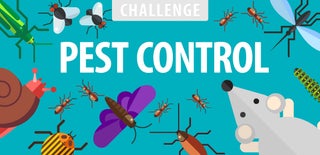Introduction: Prepare
In a garden, you want to attract as much life as possible. As a general rule to host your troops, you need Water, Food, Shelter, and Nesting. The biggest thing you've got to remember is to leave their environments alone as in don't disturb their living areas.
Step 1: Prepare- Water
Water is essential to all life. Especially in drier places like where I live (Nevada), you need to make sure there is water available at a times. Water is especially important in Winter if water freezes. To have water available, use bird baths, and puddles. Perhaps let the water faucets outside slowly drip onto a dish. Also, make sure to allow places for insects to land like a rock landing.
Step 2: Prepare- Food
Most food will be coming from flowers. You want to have flowers that bloom at different times especially early in the season. It's also important to have variety. Another source of food that is crucial to the war are the pests which will be discussed later.
The photo is of the Nevada rangeland which is also suitable.
Step 3: Prepare- Shelter
Many insects overwinter(bunker down for winter) inside grasses, soil, wood, leaves, mud and many other places. Things like bees appreciate holes of various sizes in a block of wood or even a box full of straws.
Step 4: Prepare- Nesting
Nesting is quite different from Shelter in that nesting allows your troops to reproduce safely and effectively. Plant tissues, under rocks and areas mentioned in shelter.
* Everything was supposed to be untouched but my dad went into the garden and "cleaned it up".
Step 5: Be on the Lookout
Once the enemies(pests) begin to arrive, you'll want to know what you have. The best time to be in the garden is before the sun is highest and hottest. Learn what the enemy likes to feed on.
And don't kill anything!
The photo shows a ladybug larvae that startled me.
Step 6: Strategy
Is there a plant that the enemy loves to feed on and other plants that seem to repel them? Use that to your advantage! Pests like aphids can be good or bad. If there is a plant that they really enjoy, you can leave it and it will be the food source for super beneficial insects like ladybugs.
Is there a plant that seems to repel your enemies? Grow that plant near plants you do wants keep. Often times, Garlic and Rosemary aren't struck by the enemy so put those with your beloved cucumber or strawberry.
Step 7: Post-War Results
Take a look at what may have happened in the battlefield. If you had parasitic wasp troops that attacked aphid enemies, you may now have zombie aphids with baby wasps eating itself out. Take this moment to assess what could've been done better.
The golden circle on the yellow leaf is actually an aphid that was attacked by a wasp (these wasps are small and good) and has become a shell for the next killer to pop out.
Step 8: Honoring the Troops
Birds- Great at eating insects you often don't want.
Spiders- One of the unsung heroes.
Ladybugs- ladybug larvae looks like an alien but are the biggest killers.
Parasitic Wasps- Lets talk about those zombie bugs that are now a shell incubating another killer.
Detrivores- Literally the foundation. Helped build the soil and keep the plants heathy and/or strong.
Lizards- If they are in your area; likely swallowed hundreds of unwanted pests.
Step 9: Reconnaissance
These are some resources for my area (Northern Nevada) although, could be applied else where.
Also take a look at ATTRA;
https://attra.ncat.org/attra-pub/biorationals/
This is a pest and -cide database.

Participated in the
Pest Control Challenge

Participated in the
Hack Your Day Contest













